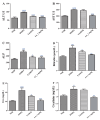Arjunolic Acid From Terminalia ivorensis A. Chev (Combretaceae) Possesses Anti-Breast Cancer Effects In Vitro and In Vivo
- PMID: 40908716
- PMCID: PMC12411669
- DOI: 10.1002/cnr2.70337
Arjunolic Acid From Terminalia ivorensis A. Chev (Combretaceae) Possesses Anti-Breast Cancer Effects In Vitro and In Vivo
Abstract
Background: Breast cancer is a major public health issue. In 2022, approximately 4,207 new cases and 2,285 deaths were reported in Cameroon. Given the limited accessibility and various issues associated with conventional treatments, herbal medicine has emerged as a promising alternative.
Aims: This study aimed to evaluate the potential anticancer activity of naturally occurring compounds isolated from Terminalia ivorensis A. Chev.
Methods and results: This was done by fractionating the methanolic extract of T. ivorensis and purifying the constituents obtained using conventional chromatographic techniques. Thereafter, the crude extract and its 5 isolates were subjected to in vitro MTT bioassay to assess their potential to kill human (MCF-7 and MDA-MB-231) and murine (4T1) breast cancer cell lines. Furthermore, the potential of the most active compound (arjunolic acid) to mitigate DMBA-induced breast cancer in rats was tested. Treatments were administered for a period of 121 days; the group of rats treated with arjunolic acid (1 mg/kg) was compared to the group that received tamoxifen at 3.3 mg/kg (standard), as well as to the normal and negative control groups. Key parameters assessed included survival, tumor burden, cytokine profiles, as well as hematological, hepatic, and renal functions. Out of the 5 isolates [lupeol (1), betulinic acid (2), Arjunolic acid (3), 3,3'-Di-O-methylellagic acid-4'-O-β-D-glucopyranoside (4) 3,3',4'-Tri-O-methylellagic acid-4-O-β-Dglucopyranoside (5)] from T. ivorensis, compound (3) had the most significant inhibitory effect against breast cancer cells growth with an average CC50 of 20 μg/mL. In vivo, a significant reduction (~89%) in tumor burden and favorable modulation of inflammation, characterized by a decrease in pro-inflammatory cytokines (TNF-α, IFN-γ, IL-6, VEGF) and an increase in anti-inflammatory IL-10 was observed. Moreover, treatment with arjunolic acid led to improved survival and maintenance of body weight, without inducing any notable adverse effects.
Conclusion: Arjunolic acid should receive more attention as a candidate for an effective therapeutic option, combining anticancer effects with beneficial anti-inflammatory activity. We encourage further studies on this compound to better understand its mode and mechanism of action.
Keywords: Terminalia ivorensis; DMBA; anti‐inflammatory; arjunolic acid; breast cancer; cytokines.
© 2025 The Author(s). Cancer Reports published by Wiley Periodicals LLC.
Conflict of interest statement
The authors declare no conflicts of interest.
Figures





References
-
- Bray F., Laversanne M., Sung H., et al., “Global Cancer Statistics 2022: GLOBOCAN Estimates of Incidence and Mortality Worldwide for 36 Cancers in 185 Countries,” CA: A Cancer Journal for Clinicians 74, no. 3 (2024): 229–263. - PubMed
-
- Ferlay J., Ervik M., Lam F., et al., Global Cancer Observatory: Cancer Today (International Agency for Research on Cancer, 2024), https://gco.iarc.who.int/today.
-
- Essiben F., Monda E., Batoum V., et al., “Therapeutic Itineraries for Women With Breast Cancer in Two University Hospitals in Yaoundé: Therapeutic Itineraries for Breast Cancers in Yaoundé,” Health Sciences and Disease 23, no. 1 (2022): 114–121, http://hsd‐fmsb.org/index.php/hsd/article/view/3254.
MeSH terms
Substances
Grants and funding
LinkOut - more resources
Full Text Sources
Medical
Miscellaneous

